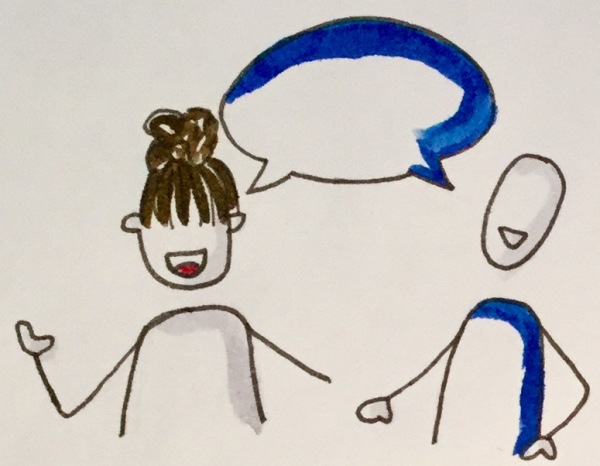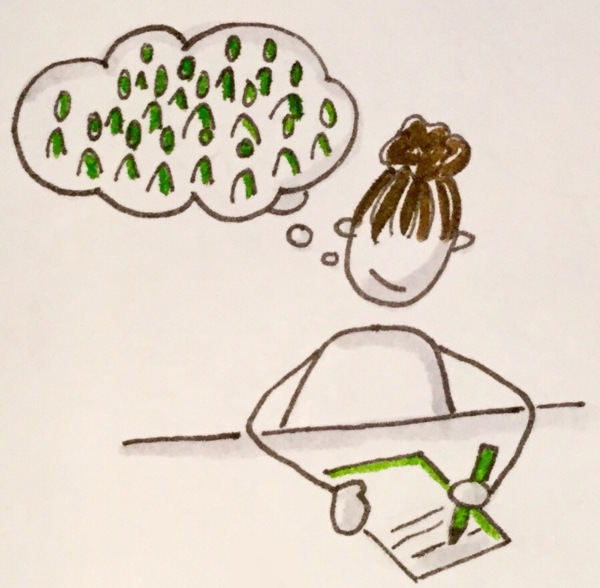From Learning Journey to Thematic Building Blocks – Part 3 of the ‘How to Plan a Training’ series
Ever wondered how to narrow down all the content you want to cover in a seminar or training? How to use good aims and objectives to develop topics and concepts for a training? Or how to translate the learning journey in actual blocks of content that you can dedicate sessions to? If you sais yes to any of those questions, this is your blogpost! Intro
In this blog post, I will guide you through the process I use to define the Thematic Building Blocks for a training. What those are I will explain in a moment, but first I want to set the scene, where in my four-step approach to planning an educational activity we are.
In the first part of the ‘How to plan a training’ series, I took you through the steps necessary to define laser-sharp aims and objectives. Check the post out for more information! In short, you need to focus on keeping your objectives as specific, achievable and realistic as possible. Next, in part 2, we looked at those as the different elements for a successful learning journey you want to take you participants. Check here for more details, but in short, I offered you three different approaches to create a draft agenda. The first one was focusing on a logical order of the objectives. The second looked on the development a participant will go through during the event. And the third referred to the hero’s journey my facilitator friend Bastian Küntzel over at Incontro proposes in his book ‘The Learner’s Journey – Storytelling as design principle to create powerful learning experiences’.

Now that we have aims and objectives as well as a draft agenda, we want to combine those with the overall content of the educational activity. For that, I want to offer you the following analogy:

Imagen the human spine. It’s an intricate system of different parts that all serve a different purpose but are all essential for us to stand, sit, walk around or do any kind of activity with our body. Same goes for the success of an educational event and the equivalent to the bones of our spine – the vertebrae – are the Thematic Building Blocks.
Those are all the different pieces of content you want to cover during an educational activity. These can be concepts and terms as well as skills or attitudes you want participants to master or reflect on. They are predefined by the aims and objectives as well as the learning journey and will give you the frame to develop the concrete sessions.

Let’s see how we can come up with them by using an example:
We are planning a training on climate change and its social impacts. It will consist of eight sessions, and the participants are youth activists that work on a local level with displaced people.
As learning aims, we have formulated the following:
- Participants explore the social impact of climate change.
- Participants can articulate the connection between this impact and displacement.
As objectives we set:
- During the training, participants gain knowledge regarding the effects of climate change in rural communities in the global south.
- Participants develop displacement profiles through case studies.
- Participants explore the connection between climate change and displacement.
- Participants learn about reasons for displacement by building on each other’s expertise.
- Participants present the social dimension of climate change to stakeholders in the decision-making process.
The narrative of the learning journal would be:
Participants work on reasons for displacement, starting from their own experience on the local level. Next, they are taking it to the global level, generalise it and add the impact of climate change to their perspective. They close the activity by bringing it back to the local level and formulate the tangible effect it has in their municipalities.

To start, I would look for keywords in both the aims and objective but also especially in the learning journey. These can be important concepts or terms which need definition or summarising titles that need to be untangled. Below you can see what I would identify for our examples:
- Climate Change
- Displacement
- Local context
- Global Context
- Social impact
- Rural community
- Stakeholder
As concepts like climate change and displacement are enormously huge, I would create mindmaps to further dissect those terms and concepts – always keeping it in the context of the training focus.

Looking at the different mindmaps, I would try to identify intersection and interesting aspects but would also start crossing out ‘irrelevant’ tangents.

Referring back to the learning journey I defined prior, I would attempt to arrange the different aspects in corresponding order. At this stage, I would also decide if there would be a need an adjustment in the learning journey to fit this analysis. The ‘essential’ building blocks and those specific for this educational event would be added in at this stage.

These are the Thematic Building Blocks! As mentioned before they represent the general flow of the different sessions. What needs to be done now, would be to define how many sessions will be dedicated to each building block and what will be the focus (speak aims and objectives ;)) of each of the session. I usually use the same approach here as I would for the aims and objectives for the overall activity. Check out part 1 of the ‘How to Plan a Training’ series if you want to learn more about this process.

Risks & traps
Go big or go home is not the right approach here. No matter how interesting an aspect in your mindmap is if it does not fall into the scope of the activity, you have to let it go. Also, be aware that a connection that appears entirely logical to you might not work for someone else. Keep this in mind when moving from your building blocks to the methods in the next step. Participants must be able to establish these connections in how you translate down the learning journey and building blocks into the methods.
Some pro-tips
- Keep it visual: Especially if you work in a team, it helps to establish a shared understanding of the Thematic Building Blocks if you find ways to make them visual. A simple way would be to use post-its and a whiteboard.
- Get a second perspective: If you working on your own, you could share your building blocks with a friend or family member to check the logic. Maybe you even have a topic expert in your network. Get their input to the mindmap – but don’t forget to narrow it down afterwards again.
So, what do you think about this step in planning a training? Do you have a different approach or a question? Leave me a comment below. Also, it would help me out if you like and share this post with our fellow trainer friends!

In the next and last part of the ‘How to plan a training’ series, I will show what I think is essential when picking the final methods for your sessions. Stay tuned!
Love and appreciation,
Anuschka


 blog post, I will present you with different types of experts you might encounter and walk you through how to work with them in different settings.
blog post, I will present you with different types of experts you might encounter and walk you through how to work with them in different settings.
 ones.
ones. In a one-session-learning-event, there is not much more you can do than the above. It really depends on the frame the client sets. If I take the role of the moderator, I sit down with the expert beforehand to clarify the process and look at the questions I would ask. In the case of the Graphic Recording option, I would only passively participate in the session. Nevertheless, it still could be my responsibility to open and close the overall activity.
In a one-session-learning-event, there is not much more you can do than the above. It really depends on the frame the client sets. If I take the role of the moderator, I sit down with the expert beforehand to clarify the process and look at the questions I would ask. In the case of the Graphic Recording option, I would only passively participate in the session. Nevertheless, it still could be my responsibility to open and close the overall activity. For a multi-session-learning-event, I often use the sessions before the expert’s input to prepare it with the participants. For that, I would look at what knowledge or attitude they need to build to interact productively. Sometimes, I even work with the learners to formulate questions, that have the potential to increase the relevancy of the input. After the presentation, I usually would debrief the session. For that, it would be best if the expert leaves after they are done. The group would have the chance to voice their opinion on the expert in a safe space and reflect on the content. That makes it easier to build on it in the remaining time.
For a multi-session-learning-event, I often use the sessions before the expert’s input to prepare it with the participants. For that, I would look at what knowledge or attitude they need to build to interact productively. Sometimes, I even work with the learners to formulate questions, that have the potential to increase the relevancy of the input. After the presentation, I usually would debrief the session. For that, it would be best if the expert leaves after they are done. The group would have the chance to voice their opinion on the expert in a safe space and reflect on the content. That makes it easier to build on it in the remaining time. I would similarly work in a multi-day-learning-event. The point in the
I would similarly work in a multi-day-learning-event. The point in the  might even ask you to join the participants throughout the learning event and feel awkward being put into the focus. They often do not establish themselves as an expert and inputs might be diffuse. That opens the risk for a conflict of views if you have a really dominant participant or that the group does not really know what to do with the input. Unfortunately, this kind of expert is often young and/or female.
might even ask you to join the participants throughout the learning event and feel awkward being put into the focus. They often do not establish themselves as an expert and inputs might be diffuse. That opens the risk for a conflict of views if you have a really dominant participant or that the group does not really know what to do with the input. Unfortunately, this kind of expert is often young and/or female.  the process. They often have an educational background or at least are experienced in the setting. They usually are aware of the space they take and incorporate the learners’ discussions into upcoming inputs. So, if that does not happen, the different moments of the expert might seem disconnected. This kind of experts can also stir your process in an unplanned direction.
the process. They often have an educational background or at least are experienced in the setting. They usually are aware of the space they take and incorporate the learners’ discussions into upcoming inputs. So, if that does not happen, the different moments of the expert might seem disconnected. This kind of experts can also stir your process in an unplanned direction.


 Once you have hammered that out, you need to look at the transformation you want the learner to go through. What is the learning journey you want to design? Who are they going into the activity and who are they going out? What experiences and challenges will support them along the way? Where do you want them to start working and towards what?
Once you have hammered that out, you need to look at the transformation you want the learner to go through. What is the learning journey you want to design? Who are they going into the activity and who are they going out? What experiences and challenges will support them along the way? Where do you want them to start working and towards what?
 In the
In the 




 session. Or you just finished this facilitation book, and there are a million and one methods you want to try out NOW! And sometimes it is the anxiety of not covering enough to make it an active and engaging training.
session. Or you just finished this facilitation book, and there are a million and one methods you want to try out NOW! And sometimes it is the anxiety of not covering enough to make it an active and engaging training. blueprint session outline with EVERYTHING. Pack all the methods and subtopics in there and do not care about the time frame. Pretend you can keep your participants forever.
blueprint session outline with EVERYTHING. Pack all the methods and subtopics in there and do not care about the time frame. Pretend you can keep your participants forever.
 Remember the four hats from my
Remember the four hats from my  Create exciting handouts or even a small magazine. The possibilities are endless!
Create exciting handouts or even a small magazine. The possibilities are endless!
 need to be established and the skills that need to be developed or extended.
need to be established and the skills that need to be developed or extended. I wanted to try for so long! What a sweet feeling
I wanted to try for so long! What a sweet feeling training are and what information is needed. Then I put on the hat of the participants and ask myself what will be the experience during the training. With the topic hat in the third step, I discover what information and which skill is need when. And finally with my favourite hat – the hat of the methods – I choose which method will serve the participants and their learning the best.
training are and what information is needed. Then I put on the hat of the participants and ask myself what will be the experience during the training. With the topic hat in the third step, I discover what information and which skill is need when. And finally with my favourite hat – the hat of the methods – I choose which method will serve the participants and their learning the best.